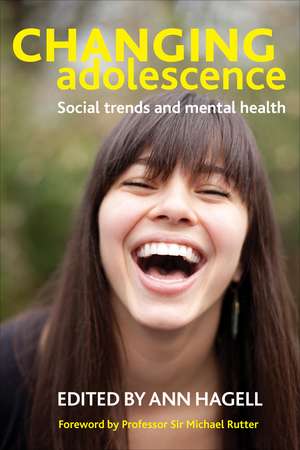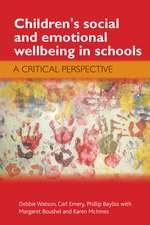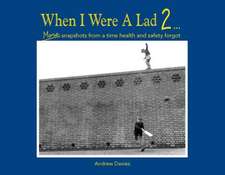Changing Adolescence: Social Trends and Mental Health
Editat de Ann Hagellen Limba Engleză Paperback – 14 mar 2012
Are today’s young people more stressed, anxious, distressed, or antisocial than they used to be? What does research tell us about the adolescent experience today and how it has changed over time? And how do trends in adolescent well-being since the 1970s relate to other changes in education, leisure, communities, and family life? Delving into topics such as stress, parenting, school experience, drug and alcohol use, neighborhoods, peers, and consumerism, Changing Adolescence explores how society-wide changes may affect young people’s behavior, mental health, and transitions toward adulthood.
| Toate formatele și edițiile | Preț | Express |
|---|---|---|
| Paperback (1) | 282.29 lei 22-36 zile | |
| Bristol University Press – 14 mar 2012 | 282.29 lei 22-36 zile | |
| Hardback (1) | 829.71 lei 43-57 zile | |
| Bristol University Press – 14 mar 2012 | 829.71 lei 43-57 zile |
Preț: 282.29 lei
Nou
Puncte Express: 423
Preț estimativ în valută:
54.02€ • 56.54$ • 44.96£
54.02€ • 56.54$ • 44.96£
Carte disponibilă
Livrare economică 10-24 martie
Preluare comenzi: 021 569.72.76
Specificații
ISBN-13: 9781447301035
ISBN-10: 144730103X
Pagini: 256
Dimensiuni: 152 x 229 x 15 mm
Greutate: 0.36 kg
Ediția:New.
Editura: Bristol University Press
Colecția Policy Press
ISBN-10: 144730103X
Pagini: 256
Dimensiuni: 152 x 229 x 15 mm
Greutate: 0.36 kg
Ediția:New.
Editura: Bristol University Press
Colecția Policy Press
Notă biografică
Ann Hagellis a chartered psychologist with a longstanding interest in social policy and adolescent well-being and the editor of the Journal of Adolescence.
Cuprins
List of tables and figures
Acronyms and abbreviations
Notes on contributors
Acknowledgements
Foreword by Professor Sir Michael Rutter
1. Introduction
Ann Hagell
2. Time trends in young people's emotional and behavioural problems, 1975–2005
Stephan Collishaw
3. Stress and mental health in adolescence: interrelationship and time trends
Ann Hagell, Sija Sandberg and Robert MacDonald
4. Trends in adolescent time use in the United Kingdom
Ann Hagell, Stephen C. Peck, Nicole Zarrett, J. Ignacio Giménez-Nadal and Jennifer Symonds
5. Trends in parenting: can they help explain time trends in problem behaviour?
Frances Gardner, Stephan Collishaw, Barbara Maughan, Jacqueline Scott, Karen Schepman and Ann Hagell
6. Educational changes and possible links with adolescent well-being: 1970s to 2000s
Ann Hagell, John Gray, Maurice Galton and Colleen McLaughlin
7. Trends in adolescent substance use and their implications for understanding trends in mental health
Ann Hagell, Judith Aldridge, Petr Meier, Tim Millar, Jennifer Symonds and Michael Donmall
8. Some thoughts on the broader context: neighbourhoods and peers
Ann Hagell, Sarah Curtis, Shari Daya, Yasmin Khatib, Rachel Pain, Catherine Rothon, Stephen Stansfeld and Sara Fuller
9. Reflections and implications
Ann Hagell and Sharon Witherspoon
References
Appendix I: The Nuffield Foundation's Changing Adolescence Programme
Appendix II: Reference list for primary data sources for graph data in Chapter 7
Index
Acronyms and abbreviations
Notes on contributors
Acknowledgements
Foreword by Professor Sir Michael Rutter
1. Introduction
Ann Hagell
2. Time trends in young people's emotional and behavioural problems, 1975–2005
Stephan Collishaw
3. Stress and mental health in adolescence: interrelationship and time trends
Ann Hagell, Sija Sandberg and Robert MacDonald
4. Trends in adolescent time use in the United Kingdom
Ann Hagell, Stephen C. Peck, Nicole Zarrett, J. Ignacio Giménez-Nadal and Jennifer Symonds
5. Trends in parenting: can they help explain time trends in problem behaviour?
Frances Gardner, Stephan Collishaw, Barbara Maughan, Jacqueline Scott, Karen Schepman and Ann Hagell
6. Educational changes and possible links with adolescent well-being: 1970s to 2000s
Ann Hagell, John Gray, Maurice Galton and Colleen McLaughlin
7. Trends in adolescent substance use and their implications for understanding trends in mental health
Ann Hagell, Judith Aldridge, Petr Meier, Tim Millar, Jennifer Symonds and Michael Donmall
8. Some thoughts on the broader context: neighbourhoods and peers
Ann Hagell, Sarah Curtis, Shari Daya, Yasmin Khatib, Rachel Pain, Catherine Rothon, Stephen Stansfeld and Sara Fuller
9. Reflections and implications
Ann Hagell and Sharon Witherspoon
References
Appendix I: The Nuffield Foundation's Changing Adolescence Programme
Appendix II: Reference list for primary data sources for graph data in Chapter 7
Index
Recenzii
“Ann Hagell and her co-authors have performed an immensely valuable service in clearly delineating what we currently know, don’t know and ought to know about adolescent life courses. We see here young people growing up both faster and more slowly, as well as creating and responding to a rapidly changing social, economic and cultural context. The book not only shows what a rich and nuanced world this is, but also how it can be subject to unhelpful and ill-informed stereotyping. The authors succeed in getting us beyond a familiar deficit model but to a place where we can be cautiously optimistic about the second decade of life.”
“Full of important new information about today's young people, and their parents, Changing Adolescence documents how the lives of adolescents have undergone enormous changes in recent history which are accelerating. This book provides a badly needed clear and exciting social science agenda to uncover the consequences of these remarkable changes.”
“The authors use incredible depth and breadth of research in attempting to explain some of the underlying issues that could explain the problems facing British adolescents.”











